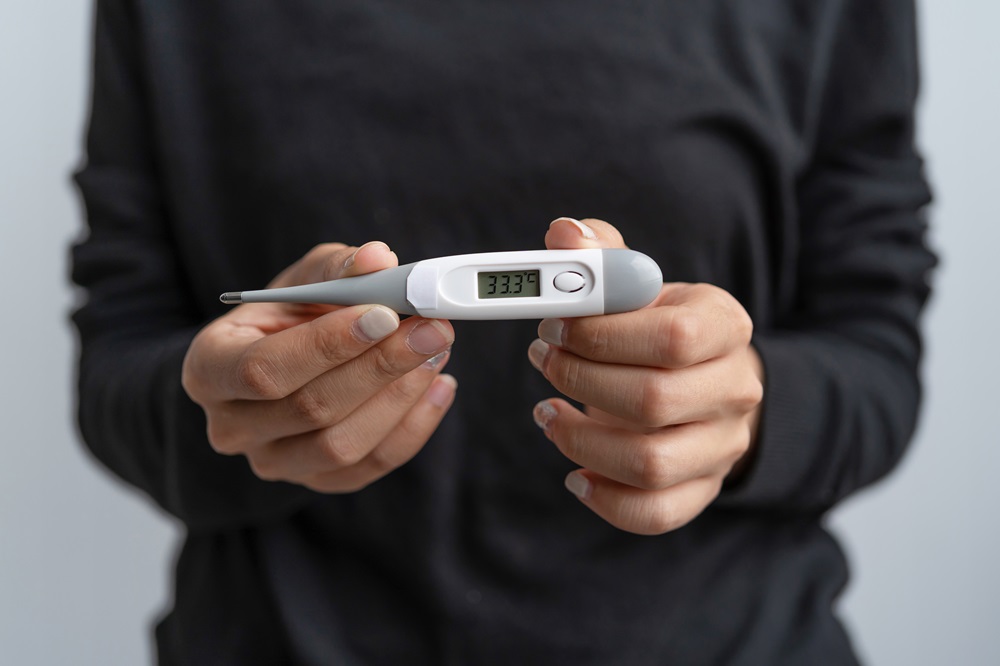Lowered body temperature – causes, symptoms, and risks

Body temperature is a crucial indicator for assessing a person’s health. The normal temperature, typically observed on a thermometer among healthy individuals, is around 36.6°C. However, sometimes, due to environmental factors, measurement errors, or certain illnesses, the body temperature may decrease. What does a low body temperature mean? What are the symptoms of hypothermia? Is a temperature below 36°C safe? How can you naturally raise your body temperature? Is a temperature of 37°C normal?
Table of contents
- What does a low body temperature mean?
- What causes low body temperature?
- Causes of hypothermia and low body temperature - why does the body lose heat?
- Diseases and low body temperature
- Low body temperature due to medications and other substances
- Symptoms of low body temperature - when should you be concerned?
- Symptoms of hypothermia
- When to seek medical help for low body temperature?
- Consequences and risks of low body temperature
- What’s the danger of very high TSH?
- How to raise your body temperature? Home remedies
- Spices and supplements for raising body temperature
- Low body temperature in children - what to do?
- Low body temperature during pregnancy
- Low body temperature - summary
What does a low body temperature mean?
The normal human body temperature ranges between 36.5°C and 37.0°C, with an average of 36.6°C considered normal. For children, the typical range is between 36.0°C and 37.5°C, while for older adults, it is between 35.8°C and 36.9°C.
While the temperature indicated by a thermometer may vary depending on the measurement location, the time of day, or even the phase of the menstrual cycle, a lowered body temperature often causes concern. But is it justified? What exactly is hypothermia, and when can we say the body temperature is too low?
What causes low body temperature?
Low body temperature occurs when the thermometer reads below 36.5°C but does not fall below 35.0°C. Hypothermia, a condition where the body loses heat faster than it can produce it, occurs when the temperature drops below 35.0°C.
This condition can lead to serious consequences, including brain damage, heart failure, or even death.
Causes of hypothermia and low body temperature - why does the body lose heat?
There are many reasons why body temperature might drop. A low temperature should not be alarming if it’s a temporary condition. The most common cause of a low body temperature is a measurement error, which occurs when the electronic thermometer is not placed correctly or used for an insufficient amount of time.
Among women, a low temperature can also occur during the follicular phase of the menstrual cycle, which happens before ovulation or just before menstruation begins.
External factors, such as wearing thin clothing inappropriate for the weather, or being in wet clothes, can also lead to a temporary drop in body temperature. The body temperature may decrease in a cold room, or as a result of dehydration. A drop in temperature is not a cause for concern during a common cold.
Diseases and low body temperature
If a low body temperature persists for an extended period, it's important to consult a doctor. A consistently low temperature can be linked to several serious health conditions, such as:
- hypothyroidism
- adrenal insufficiency
- diabetes
- hypoglycemia
- sepsis
- pituitary insufficiency
- kidney failure
- anemia
- raynaud's disease
- liver failure
- malnutrition
- metabolic disorders
Since the hypothalamus regulates body temperature by receiving signals from thermal receptors, hypothermia and prolonged low body temperature can also result from neurological disorders, such as:
- multiple sclerosis
- stroke
- parkinson’s disease
- spinal cord injury
- intracranial bleeding
Low body temperature due to medications and other substances
Chronic alcohol consumption and drug use, especially over a long period, can also cause lowered body temperature. Additionally, exposure to toxins or the use of certain medications can lead to a drop in body temperature.
For example, beta-blockers, used in cardiological treatments, as well as certain anti-anxiety and sedative medications, can contribute to a decrease in body temperature. Overuse of fever-reducing medications may also result in a lower body temperature.
Symptoms of low body temperature - when should you be concerned?
A short-term decrease in body temperature usually doesn’t result in significant symptoms, although it might cause fatigue, weakness, or drowsiness.
However, if the body temperature remains low for a longer period, symptoms like dizziness (especially upon waking), heart palpitations, confusion, and pale skin may appear. Cold sweats are also common when the body temperature is low, particularly after waking up or prolonged immobility.
Symptoms of hypothermia
In mild hypothermia, when the body temperature is around 35°C, the person may experience:
- shivering
- muscle spasms
- rapid heartbeat
- vasoconstriction
- muscle stiffness
At 34°C or lower, consciousness may become impaired, and sensitivity to stimuli may diminish. With temperatures below 28°C, severe hypothermia can cause weak or absent pulse and unresponsive pupils, putting the person at direct risk of death.
When to seek medical help for low body temperature?
Short-term decreases in body temperature are usually not a cause for concern. However, if a low temperature is accompanied by alarming symptoms, it’s essential to consult a doctor for a thorough medical interview and appropriate diagnostics, such as thyroid hormone levels, antibody and white blood cell counts, or blood glucose tests.
If hypothermia is suspected (when the body temperature is below 35°C), the person should be protected from further heat loss using methods like a thermal blanket, a common first aid item. Other helpful options include a hot water bottle, warm tea, a thick blanket, and dry clothes.
It's also important to seek medical help, as doctors can apply active warming techniques, such as using a heated air blanket or intravenously administered fluids. In severe cases, extra-corporeal circulation warming may be needed.
Consequences and risks of low body temperature
Prolonged low body temperature can result in a negative heat balance, increasing the risk of hypothermia, which varies depending on the degree of heat loss.
A temperature below 36°C (or 35.5°C in adults) can lead to complications like arrhythmia or respiratory failure, as well as frostbite. Hypothermia can damage tissues and, in extreme cases, lead to necrosis, requiring amputation.
Severe hypothermia may also cause loss of consciousness and organ failure, which can be fatal.
What’s the danger of very high TSH?
Hormonal disorders, particularly those affecting the thyroid, can lead to lowered body temperature. Thyroid hormones (FT3 and FT4) play a role in regulating body temperature.
One of the most common causes of low body temperature is hypothyroidism, which involves elevated TSH levels and decreased FT3 and FT4 levels.
High TSH levels can cause symptoms such as feeling cold, increased sensitivity to cold, fatigue, drowsiness, dry skin, and difficulty concentrating, all of which may disrupt normal bodily functions.
How to raise your body temperature? Home remedies
In cases of hypothermia, it’s important to protect the body from further heat loss and seek medical assistance. However, there are also natural ways to raise your body temperature when it’s around or below 36°C. Here are some methods to naturally increase body temperature:
- Dress appropriately: Layering clothing, especially with natural fabrics, can help trap heat.
- Thermal pads and baths: A hot water bottle, warm bath, or drinking hot beverages like tea with honey and lemon can provide relief.
- Exercise: Light physical activity can stimulate blood circulation and help increase body temperature.
Spices and supplements for raising body temperature
If you're wondering how to increase body temperature, including warming spices and supplements in your daily diet can help. Some useful options include:
- Chili, ginger, cardamom, cinnamon, turmeric, mustard, cloves, black pepper, and nutmeg.
Consider supplements like:
- OstroVit Kurkumina + Black Pepper + Ginger (90 tablets), which contains three valuable plant extracts that may boost thermogenesis.
- OstroVit Piperine 95 VEGE (180 capsules), a supplement containing black pepper extract standardized to 95% piperine, which may increase thermogenesis and regulate metabolism.
To maintain body temperature, focus on a well-balanced diet, which can include the above spices, along with fresh fruits, vegetables, whole grains, healthy fats, and lean dairy products. Also, drink plenty of fluids to stay hydrated and support your metabolism.
Low body temperature in children - what to do?
A child’s low body temperature, like in adults, can have many causes, including infections or environmental factors such as cold rooms, wet diapers, or improper clothing. In some cases, low body temperature in children may be due to malnutrition, dehydration, or anemia, and it can be associated with certain diseases, including sepsis.
Young children, particularly infants, are more vulnerable to temperature drops because their bodies are still developing thermoregulatory mechanisms. Infants are more prone to sweating and may easily become chilled.
When should you seek medical help for a child with low body temperature? Consult a doctor if the low temperature lasts for an extended period or if other concerning symptoms are present. Immediate medical attention is necessary if a child's body temperature drops below 36°C, as temperatures of 35.8°C or lower can quickly lead to hypothermia, which is life-threatening.
Low body temperature during pregnancy
Pregnancy can put significant stress on a woman’s body, and it’s not uncommon for expectant mothers to experience slight drops in body temperature due to the increased metabolism and heat production needed to prevent overheating.
Typically, a pregnant woman's body temperature ranges from 36.4°C to 36.6°C. However, if the temperature falls too low, it could signal anemia or a drop in progesterone levels, which could potentially indicate a miscarriage. Therefore, any concerns about low temperature during pregnancy should be discussed with a healthcare provider.
Low body temperature - summary
A drop in body temperature results from a disparity between the body's ability to produce heat and its heat loss. Small fluctuations in body temperature are a normal physiological phenomenon and can depend on factors like the time of day.
However, prolonged low body temperature can be linked to hormonal imbalances or serious health conditions. Therefore, if symptoms occur, it's important to consult a doctor and undergo proper diagnostics. It's also a good idea to regularly monitor temperature, as a drop below 35°C can lead to hypothermia, posing a direct threat to life.
To raise body temperature, natural methods such as wearing appropriate clothing or taking a warm bath should be considered. Paying attention to your daily diet and maintaining proper hydration are also key. Additionally, vitamins and immune-boosting herbs may help reduce the risk of infections while also lowering the chances of experiencing low body temperature.

